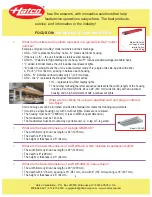
040-563
2018-10
Operating Manual
Model/Series:
Number:
GB
Version:
Rev. D
Page 11 of 16
©
DEUBLIN
for air and hydraulic
with elastomeric seals
4.6.3 Using an anti-rotation element
Fig. 6: Example of an anti-rotation element
The rotating union must be secured against rotation during operation using an anti-rotation element
(2)
. The connections of the hoses
(1)
can be used as torque supports.
A fork head may e.g. be installed on-site to serve as an anti-rotation element at a hose connection.
The connector of the hose
(1)
may in this example only touch
against one side of the bracket
(2)
of the anti-rotation ele-
ment so that a clearance
(X)
remains between the other side
of the bracket and the hose connector.
Fig. 7: Top view torque support
4.6.4 Optional: Connection of a leakage line
To prevent surrounding components from being damaged by escaping medium, you can connect a
leakage line to some rotating unions with separate leakage line, if required.
Some rotating unions are provided with relief bores (leakage
connections) for ventilation and leakage discharge.
❑
When used in dirty environment, we recommend protect-
ing the leakage holes against penetrating dirt. If you close
all relief bores, pressure builds up resulting in the prema-
ture wearing out of seals.
❑
Position the rotating union in a way that you can always
connect the leakage line in 6 o’clock position (at the lowest
point) to a leakage hole.
❑
The leaking medium has to be conveyed pressureless
back to the tank.
Fig. 8: Schedule connection of leakage line
1
2
x
2
1


































